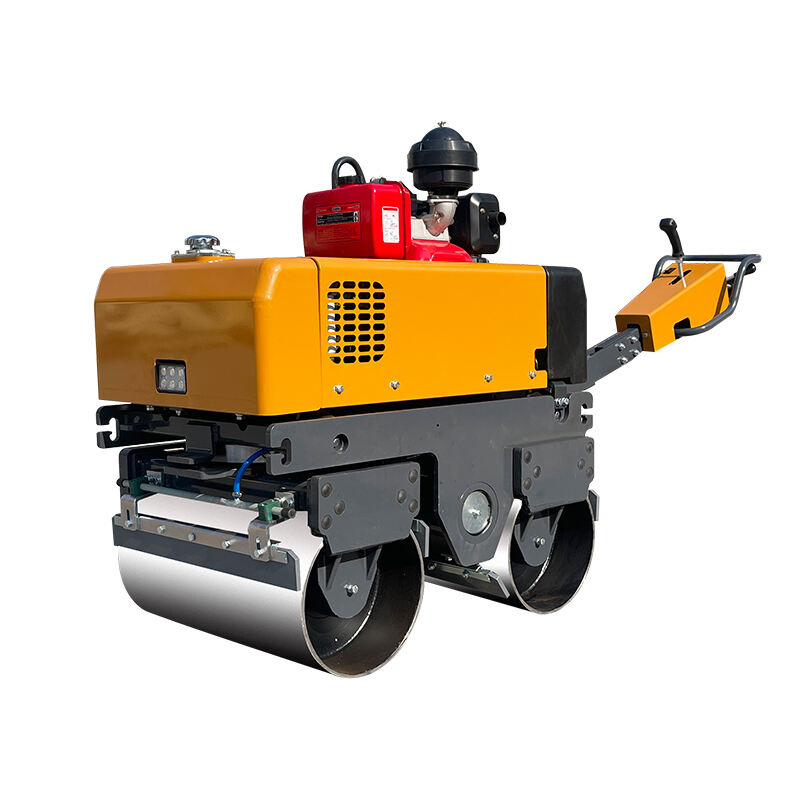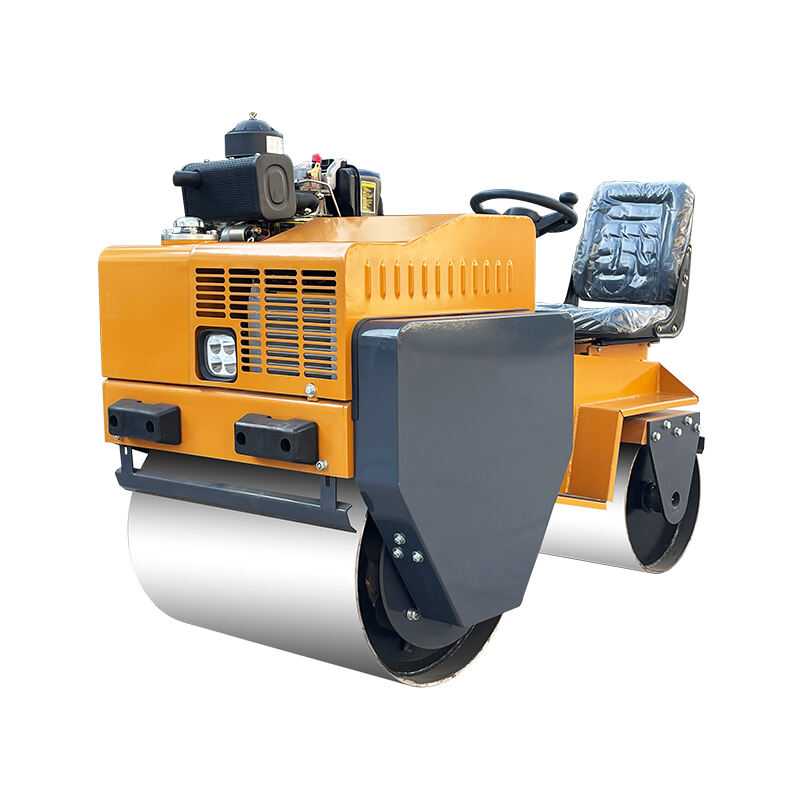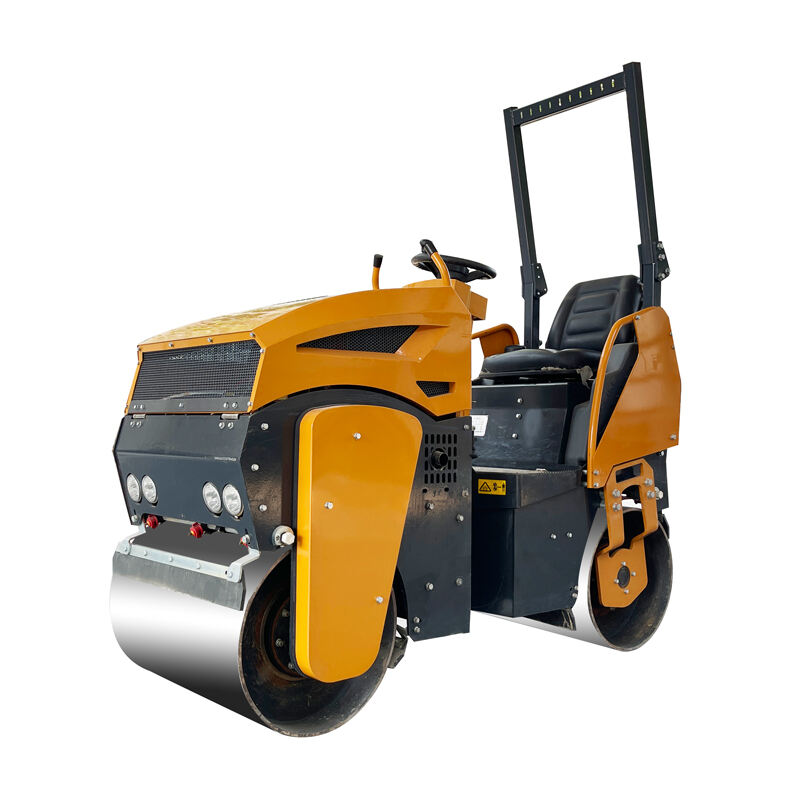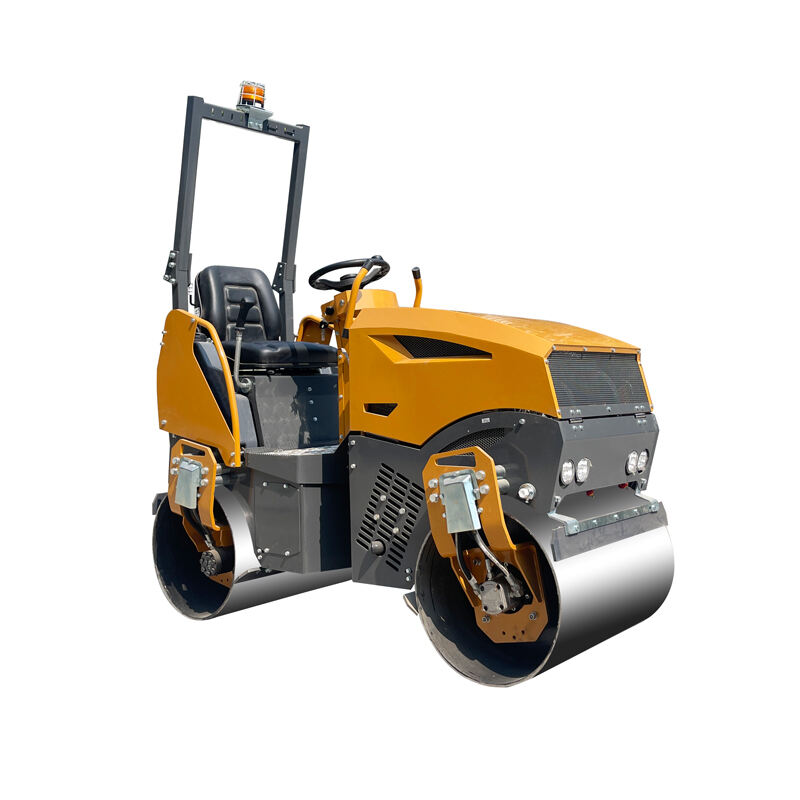Advanced Features of Vibratory Roller Compactors
Key Innovations in Vibratory Roller Compactors
Hydraulic Systems and Vibration Control
Putting hydraulic systems into vibratory roller compactors represents a major step forward in how these machines work. These systems give operators much finer control over both force application and vibration levels during operation, which makes it easier to manage the actual compaction process on site. What this means practically is that contractors get better results without having to apply excessive pressure manually. The vibration control tech is just as important too. It stops things from getting over compacted, which saves money because there's less waste material lying around after jobs are done. Industry data shows pretty impressive numbers when looking at what these improvements actually deliver. Contractors typically see around 20% less material going to waste while projects finish about 15% faster overall thanks to consistently good compaction quality throughout. For construction firms dealing with tight budgets and demanding schedules, these kinds of efficiencies make all the difference in staying competitive in today's market.
Advanced Drum Designs for Optimal Compaction
New developments in drum construction are making a real difference when it comes to how well vibratory rollers work. Engineers have redesigned drums so they actually touch more of the ground during operation, which means better compaction throughout the entire area being worked on. We see different drum configurations now - some vibrate while others come in pieces that move independently. These variations handle everything from sandy soils to clayey ground much better than older models did. According to field reports from contractors, newer drum technology has boosted compaction rates around 30 percent in tough spots where traditional equipment just couldn't get the job done right. This improvement leads to fewer problems down the road with structures built on improperly compacted earth.
Intelligent Frequency Adjustment Technology
The ability to adjust frequencies intelligently has changed how adaptable vibratory roller compactors really are. Operators can now tweak their compaction work based on what kind of material they're dealing with. When these machines change their vibration rates automatically, they save energy and cut down on power needs something green builders care about a lot. Real world tests show pretty impressive results too. Some construction sites saw energy savings around 25% when using this frequency control tech. These improvements mean better efficiency across projects. Materials get compressed just right without wasting effort. Surfaces last longer because of this precision work. And let's face it, saving money on electricity while still getting quality results makes good business sense for contractors worried about both costs and carbon footprints.
Top-Performing Vibratory Roller Models
SVH80 | 800KG | Handheld Double Drum Design
The SVH80 vibratory roller is pretty impressive because of how small and easy to handle it actually is. Makes sense why folks love using it in those really tight spots around cities where bigger machines just won't fit. What makes this particular model work so well? It's got this handy double drum setup that packs down surfaces efficiently even when space gets really limited. People who operate these things regularly talk about how straightforward the controls feel and how comfortable the whole thing is to maneuver through rough ground conditions. Look at the numbers too there's been some solid customer feedback coming in lately. Contractors across different regions keep mentioning they can count on this machine day after day without issues popping up unexpectedly.
SVH70 | 800kg | Ride-On Operation Flexibility
The SVH70 ride on vibratory roller really stands out when it comes to getting work done faster while keeping operators comfortable throughout big jobs. What makes this machine special is how easy it moves around different job sites thanks to its sleek build, so it works great for all sorts of road building projects. People who actually operate these machines talk about how straightforward they find them to handle day after day, which means less downtime and more pavement laid down. Real world experience shows that workers actually enjoy using this equipment because everything just feels right, from the controls to the seating position. The ergonomics make a real difference in reducing fatigue during those long hours on site.
ST1000 | 1-Ton Articulated Frame Model
The ST1000 roller comes with an articulated frame that really helps when dealing with rough ground, which makes it stand out in tough environments where other machines struggle. Contractors who have used this model report better results when tackling obstacles while still keeping good compaction levels across different surfaces. Compared to similar rollers on the market, the ST1000 just moves around much better thanks to that flexible frame. This means operators can work faster without sacrificing quality, especially important for road paving jobs or large construction sites where time matters.
ST1200 | 1.2-Ton High-Torque Compactor
The ST1200 vibratory roller packs serious torque, which makes it a real workhorse when tackling those tough compaction jobs on construction sites or during road maintenance projects. Contractors who have used this machine report that it handles even the most demanding soil conditions without breaking a sweat. Operators love how dependable it is day after day. Many mention they've seen it maintain consistent results through long shifts, producing compacted surfaces that consistently pass quality inspections. Some crews have run these rollers for years and still find them holding up well against wear and tear.
ST1300 | 1.3-Ton Kubota-Powered Excellence
The ST1300 roller gets its power from Kubota's advanced engine, which helps it perform really well and stay reliable no matter what job it's tackling. Real world tests back up these claims too many contractors report getting good results when using this machine on different types of jobs around town. Plus, the ST1300 has picked up some awards lately for how smartly it was designed and how tough it is during operation. For anyone working on big construction sites where equipment needs to last through tough conditions, this model stands out among competitors because it just keeps going without breaking down.
Applications for Modern Road Construction Rollers
Asphalt Layer Compaction Techniques
Asphalt compaction remains one of the most important steps during road building projects because it directly affects how long those roads will last before needing repairs. Contractors typically rely on special equipment like vibratory rollers to get just the right thickness and smoothness in their asphalt layers. What makes these machines effective? They shake the material at high frequencies which packs together all those tiny asphalt bits into something much stronger and longer lasting than what older methods could produce. Good compaction really matters for budget reasons too since roads that aren't properly packed down tend to crack sooner and cost cities extra money for fixes down the line. Some studies show that roads built with modern vibrating rollers actually stay in good condition about 30 percent longer than ones made using conventional approaches from decades ago.
Trench Backfill Stabilization Solutions
Vibratory rollers are essential for stabilizing trench backfills and getting good soil compaction done right. When operators run these machines over filled trenches, they pack the soil tightly which stops problems like ground settling or erosion that might damage whatever structure sits above. Some civil engineering research points to around 50% less settling when the soil gets properly compacted. The trick is getting the moisture content just right before starting work, plus working in thin layers until specs are met for stable ground conditions. Most guidelines stress out how important it is to get even density throughout those trenches if we want our constructions lasting longer than expected. Industry data backs this up too showing fewer complaints about sinking foundations after proper roller passes during construction projects.
Walk-Behind vs. Ride-On Model Applications
When it comes time to pick between walk behind and ride on rollers, most contractors base their decision on what kind of work they need done and how big the job actually is. For those little jobs around town where space gets cramped and things aren't so intense, walk behind machines tend to be the go to option because they can squeeze into tight spots so easily. Ride ons make more sense when dealing with bigger sites that require covering ground quickly without wearing out the crew. These larger machines just plain get more done faster since operators stay comfortable during long hours of operation. Most seasoned pros will tell anyone who asks that ride on rollers dominate the market for major compaction work at construction sites, while walk behind units remain indispensable for getting into those awkward corners behind buildings or around existing structures. Knowing the difference between them isn't just academic knowledge either it directly affects whether a project finishes on time and within budget.
Efficiency Benefits of Advanced Compactors
Fuel Optimization Through Smart Systems
New generation compactors are changing how construction works through their smart tech that cuts down on fuel usage quite a bit. The onboard systems collect live information about what's happening around them and tweak the engine accordingly so it runs efficiently while still packing enough punch for tough jobs. Some contractors who switched to these machines saw their fuel bills drop by about 15 percent after putting them into action on site. Lower fuel spending means saving money, sure, but there's another big plus too fewer harmful gases going into the air. That makes a real difference for the environment since construction sites tend to be major sources of pollution. With cleaner air coming from these operations, we're actually making progress against global warming problems while keeping our work areas greener overall.
Reduced Maintenance with Robust Components
Using strong materials and quality parts in modern compactors means they don't need constant fixing and adjusting. When manufacturers build their machines with tough stuff that can handle rough environments, this translates into fewer breakdowns and less time spent on repairs. Take a look at what some industry numbers show companies actually save money too. One study found businesses saw around 20 percent less spending on maintenance after switching to these better built models. People who know their way around equipment maintenance often point out something important about durability. Good quality machines cut costs yes, but they also boost productivity because there are simply fewer problems to deal with over time. Less time wasted on fixing things equals more work getting done.
Gradeability Enhancements for Sloped Surfaces
Recent improvements in compactor design have made a big difference when it comes to tackling hills and slopes during construction work. Today's compactors handle steep grades much better than their predecessors did just a few years ago. Tests show they can climb gradients around 30 percent steeper compared to older equipment models. Road builders who frequently deal with mountainous areas love what these new machines bring to the table. They finish jobs quicker because operators don't get worn out so fast climbing those tough inclines all day long. The feedback from actual construction sites makes one thing clear these upgraded compactors are game changers for anyone dealing with rugged terrain in road building projects across the country.
Operational Technology Breakdown
CE-Certified Safety Features
Safety features certified under CE standards play a vital role in keeping operators safe while using vibratory roller compactors. What makes these features stand out? Think better visibility around the machine, automatic shutdown when something goes wrong, and designs that actually consider how workers interact with the equipment all day long. On construction sites, these improvements matter a lot because they cut down on injuries and keep projects moving smoothly without constant interruptions. According to research from the European Agency for Safety and Health at Work, companies that install these safety systems see accident rates drop by around 40%. For contractors looking to protect their workforce, investing in this kind of tech does more than just meet regulations it helps build a safer working environment across the entire construction sector. Modern machinery simply wouldn't be complete without these essential CE-certified protections.
Hydraulic Steering Mechanisms Explained
The introduction of hydraulic steering on vibratory roller compactors has made a big difference when it comes to moving around in tight spots during construction work. These systems give operators much better control over their machines, so they can get through narrow alleys and around obstacles without too much hassle. When compared side by side with older steering setups, the difference is night and day. Hydraulic systems just feel smoother when turning corners and require far less physical strain from the operator. Many people who actually operate these machines talk about how much easier everything becomes once they switch to hydraulics. They mention being able to handle rough terrain that would have been nearly impossible before. For contractors working on road projects where time matters, spending money on good hydraulic steering isn't just worth it anymore – it's practically essential if they want to keep up with modern demands for both speed and accuracy in pavement laying operations.
Water-Cooled Engine Advantages
When it comes to vibratory compactors, water cooled engines bring some serious advantages to the table. They do a much better job at keeping things cool when the going gets tough, which means operators don't have to worry about engines overheating during those long days on site. The difference in lifespan between these engines and their air cooled cousins? Pretty significant actually. Industry data suggests water cooled versions can stick around about 20 percent longer before needing replacement thanks to how they handle heat. Most engine makers we talk to point out that these systems require less frequent maintenance too, plus they tend to run smoother over time. That's why so many contractors now specify water cooled engines for their road building equipment. After all, nobody wants to deal with breakdowns or unexpected repairs when there are deadlines to meet and projects to finish.
FAQ
What are the key innovations in vibratory roller compactors?
Key innovations include the integration of hydraulic systems for precise force and vibration control, advanced drum designs for maximum surface contact, intelligent frequency adjustment technology for optimal energy usage, and high-torque capabilities for heavy-duty compaction tasks.
How do modern drum designs improve compaction efficiency?
Modern drum designs are engineered to provide maximum surface contact and uniformity in compaction, improving efficiency by up to 30% in challenging soil conditions.
What benefits do intelligent frequency adjustment technologies offer?
These technologies allow operators to fine-tune compaction according to material types, optimize energy usage, reduce power consumption, and improve material compression precision and sustainability.
What are the differences between walk-behind and ride-on models?
Walk-behind models offer maneuverability for smaller tasks, while ride-on models provide higher efficiency and comfort for large-scale projects.
What advancements contribute to fuel optimization in modern compactors?
Smart systems use real-time data to adjust engine performance for optimal fuel efficiency, leading to a 15% reduction in fuel costs without compromising power.
 EN
EN
 AR
AR CS
CS DA
DA NL
NL FI
FI FR
FR DE
DE IT
IT NO
NO KO
KO PL
PL PT
PT RO
RO RU
RU ES
ES SV
SV TL
TL ID
ID LV
LV SR
SR SK
SK SL
SL VI
VI SQ
SQ ET
ET TH
TH TR
TR AF
AF MS
MS GA
GA HY
HY KA
KA BS
BS LA
LA MN
MN MY
MY KK
KK UZ
UZ KY
KY












